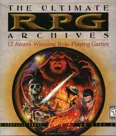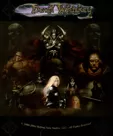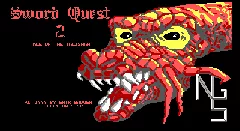Dragon Wars
Description official descriptions
Dragon Wars takes place in the magical land of Dilmun, an island of salvation perverted into a world of horror by Namtar (as you might expect - the bad guy).
The player starts with a party of four in the city of Purgatory, equipped with nothing more than.. well - nothing. Worst of all your magic users won't help you out, either, because magic has been banned (to correct this unpleasing situation is one of your main objectives). Other main targets are surviving, getting out of Purgatory and toppling Namtar (maybe getting some decent clothing, one or two shiny swords and the like on your way out).
Gameplay instantly reminds of the Bard's Tale series. Step-by-step first person 3D, opponents materialize out of the air. The combat system is turn based.
Unlike its (spiritual?) predecessors the game features a full-blown skill system, auto-mapping and many places to actually use all these abilities.
Reasonable distribution of your skill points is rather critical.
Spellings
- ドラゴンウォーズ - Japanese spelling
Groups +
Screenshots
Promos
Credits (Commodore 64 version)
11 People (10 developers, 1 thanks)
| Program | |
| Designed by | |
| Artwork by | |
| Produced by | |
| Assistant Producer | |
| Music by | |
| Cover Art | |
| Design Consultant | |
| Manual by | |
| Commodore 64 art conversion by | |
| Special Thanks to |
Reviews
Critics
Average score: 74% (based on 16 ratings)
Players
Average score: 3.3 out of 5 (based on 42 ratings with 3 reviews)
Ever seen an RPG Legend? Well this one's an RPG God!
The Good
Dragon Wars is a rare RPG that represents everything any RPG gamer could ever want in a game...and no doubt a little bit more.
The game was released around 1989, technology capabilities was minimal, but that never stopped the developers imagination for the quest for immortality represented in this game. I have to admit the creators of this game overdid themselves in creating this one.
So what does it take to be an RPG God? Well I'll show you:
**The Bad**
Those "read paragraph ##" things can be rather irritating, especially if you don't have the manual. (probably why it took me 6 years to finish this one...haha). Some skills are pratically useless though and in many cases, you only use those skills only once. Sound was minimal although back then there weren't many games with sounds either. Can't get the opening music outta my brain! :)
**The Bottom Line**
An RPG way ahead of its time. This game represents the basic values of what every RPG should have, has to have and always will have. Anything less that what this games symbolizes and accomplished means that it's just another game without brains or soul. In short: RPG Blasphemy. A hundred more or so RPG's are introduced each year. How many do you know qualify to be deemed as an RPG legend...or better yet, an RPG god? Game developers= We're waiting.
DOS · by Indra was here (20749) · 2004
A true classic CRPG I still enjoy playing
The Good
The graphics - Colourful EGA graphics with a nice 3D-view and large, animated monsters with a lot of personality.
The sound - Nice title tune and digitized sound effects, all through the beeper. (So none of that pathetic AdLib stuff they used to have back then.)
The gameplay - I just can't help but long for the days when moving from one side of the city to another in a CRPG took but a few seconds (what with block-by-block movement, controlled with the cursor keys), instead of clicking and waiting and clicking and waiting as per Baldur's Gate or Fallout (...and clicking and waiting...). I also prefer turn-based CRPG's to "real-time" ones.
The automap - 'Nuff said.
The Bad
The graphics - So the monster close-ups look good, but I wouldn't have minded if you could see the monsters/NPCs from afar. (As it is, most NPC's don't have pictures at all.) Also, the monsters don't react in any way to getting their teeth kicked in - they just loop the same fancy animations.
The plot - It's a good plot as far as it goes, but there really isn't much of it. Basically you just wander around until you're strong enough to kill the bad guy. It does have some puzzles, though, and what storyline there exists is well written.
The combat - Doesn't allow for much tactics, but that was the standard back then.
The Bottom Line
I believe this was my first (legal copy of an) IBM PC game, and I really got disoriented when playing it for the first time, as it was also the first first-person game I had ever played (the same thing happened to me when I played Doom for the first time). I was instantly hooked, however, as the graphics were just as good as in C=64 games (compared to Alleykat), and the game seemed really huge.
The game may not seem huge by todays standards, and it really isn't all that difficult, either, but it took me two computers two years to finish it, and I had a lot of fun with it. It is a fun and rewarding CRPG of its time, made by high standards, and I'd probably still play it if my 400MHz AMD would run it (I guess IBM PC-compatibles aren't all that compatible any longer).
DOS · by Late (77) · 2001
The Good
The design - there's no single path to completing the game, nothing you're forced to do in order to be able to finish. One of the first tasks you're supposed to do, for instance, is find your way out of the city you start in. Well, there's at least four different ways to do it, each leading to a somewhat different game experience (eg., different NPCs with different skills will join your party). For another, there are puzzles scattered throughout the game, but you don't have to solve every one in order to win (good, because some I never did - probably didn't have the NPC with the proper skill).
The size - this is a big game. I didn't visit all the locations the first time through. The second time through was very different from the first time - not a completely new game, of course, but like visiting another part of the same country.
The Bad
The manual - some parts of the plot are advanced by reading paragraphs in the manual. These contain vital information you won't learn any other way. They're read only when the game instructs you to read a particular one (the paragraphs are out of order, and some of them are distractors, having nothing to do with the game, in order to discourage you from reading all of them at once). These could easily have been incorporated into the game itself, but putting them in the manual enhances copy protection - the game is almost useless without the manual. What is irksome is that something designed to protect the developers against theft for the first few weeks or months of release still hampers you years later.
The graphics - these are designed for an EGA display, and look very nice. But when I upgraded to a VGA display, the image pixels didn't blend as well as they had, and they looked worse.
The Bottom Line
As I recall this game got so-so reviews when it first came out, but it's really very good. I've played much more highly reviewed CRPG games that I've found ultimately disappointing - they look nice, but the gameplay is linear and the endgames surprisingly easy. Neither of those objections applies to this game. It's so satisfying, I was unsatisfied - I had to play it again right away!
DOS · by anton treuenfels (34) · 2001
Trivia
Bard's Tale
Dragon Wars was developed as The Bard's Tale IV, but three months before release the name had to be dropped. Interplay replaced Electronic Arts with Mediagenic as their publisher and Electronic Arts owned the Bard's Tale name. It was decided to rename the game to Dragon Wars. The developers had to rewrite the story so it would fit the new title.
Default Party Characters
The party in the beginning of the game consists of four default party members (which may optionally be deleted and replaced with new characters). The original party members are: Muskels, Theb, Elendil, and Cheetah. Three additional characters may also optionally be recruited in-game, these characters are: Louie, Ulric, and Valar.
The Elendil party character in this game bears the same name with a fictional character created by author J. R. R. Tolkien, the first high king of Arnor and Gondor. One notable scene from Fellowship of the Ring, where Elendil dies fighting Sauron, his broken sword is then used to cut the One Ring from Sauron's hand.
Importable Characters
The player may transfer (import) previously made character(s) from Tales of the Unknown: Volume I - The Bard's Tale, The Bard's Tale II: The Destiny Knight or The Bard's Tale III: Thief of Fate into Dragon Wars. Transferring characters will unfortunately delete the previously saved game. The DOS version only allows importing from the first two games (the third one had not yet been ported to DOS when Dragon Wars was released) via the external command line tool DWTRAN.COM. Other versions allow importing from all three games and have an in-game utility for that purpose.
Mythology
Purgatory, the starting city in the game, comes from a legend or a myth referring to a place between earth and hell.
Reversed Spelling/Semordnilaps
Some of the names used in the game have a meaning if spelled backwards. Though it may be coincidental, there are numerous names that are used in this manner, among others: * Namtar, the bad guy's name read backwards is Ratman. * Another name used in the game, Lanac'toor, read backwards is Root Canal.
Analytics
Upgrade to MobyPro to view research rankings!
Related Sites +
-
Computer Show, The
Dragon Wars Walkthrough
Identifiers +
Contribute
Are you familiar with this game? Help document and preserve this entry in video game history! If your contribution is approved, you will earn points and be credited as a contributor.
Contributors to this Entry
Game added by Zzap.
NES added by JRK. Commodore 64 added by Rebound Boy. Macintosh, Linux, Windows added by ZeTomes. Antstream added by lights out party. Sharp X68000, Apple II, Amiga added by Terok Nor. Apple IIgs added by Scaryfun. PC-98 added by Unicorn Lynx.
Additional contributors: Terok Nor, Indra was here, Alaka, Cantillon, Patrick Bregger, Rik Hideto.
Game added July 21, 2000. Last modified August 2, 2024.






















